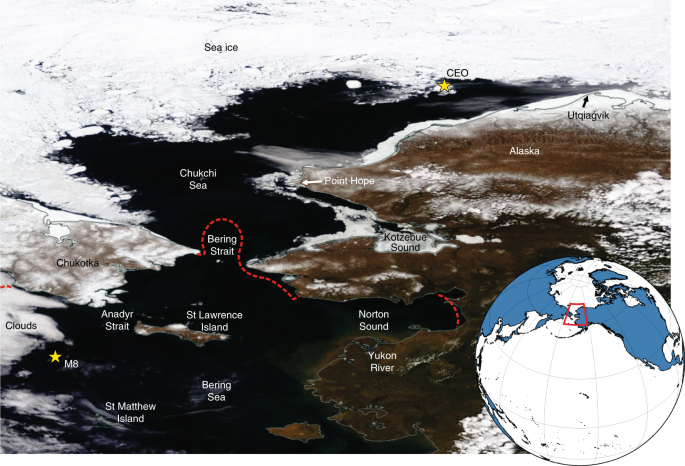
- Select a language for the TTS:
- UK English Female
- UK English Male
- US English Female
- US English Male
- Australian Female
- Australian Male
- Language selected: (auto detect) - EN
Play all audios:
The highly productive northern Bering and Chukchi marine shelf ecosystem has long been dominated by strong seasonality in sea-ice and water temperatures. Extremely warm conditions from 2017
into 2019—including loss of ice cover across portions of the region in all three winters—were a marked change even from other recent warm years. Biological indicators suggest that this
change of state could alter ecosystem structure and function. Here, we report observations of key physical drivers, biological responses and consequences for humans, including subsistence
hunting, commercial fishing and industrial shipping. We consider whether observed state changes are indicative of future norms, whether an ecosystem transformation is already underway and,
if so, whether shifts are synchronously functional and system wide or reveal a slower cascade of changes from the physical environment through the food web to human society. Understanding of
this observed process of ecosystem reorganization may shed light on transformations occurring elsewhere.
All data collected as a part of the North Pacific Research Board’s Arctic Integrated Ecosystem Research Program (Arctic IERP) are being curated and preserved. As the research is actively
ongoing, the data are under program embargo until July 2021. At that time, all Arctic IERP data will be publicly released with a CC-0 license from the Research Workspace DataONE Member Node,
and this paper will be cited in the doi for those data. In the interim, please contact the authors for access to Arctic IERP data.
In Fig. 1, we acknowledge the use of imagery from the NASA Worldview application (https://worldview.earthdata.nasa.gov/), part of the NASA Earth Observing System Data and Information System
(EOSDIS). Ice-edge marking is from ref. 51.
2015 epifauna data are available at https://doi.org/10.25921/b2g4-bs86.
Other data are available on request, pending curation and archiving as part of ongoing studies.
Much of the research reported here and preparation of the manuscript was conducted under the Arctic Integrated Ecosystem Research Program (Arctic IERP; http://www.nprb.org/arctic-program/).
This manuscript is Publication Arctic IERP-014. Funding for the programme was provided by North Pacific Research Board, the US Bureau of Ocean Energy Management, the Collaborative Alaskan
Arctic Studies Program (formerly the North Slope Borough/Shell Baseline Studies Program) and the US Office of Naval Research Marine Mammals and Biology Program. Generous support was provided
by the US National Oceanic and Atmospheric Administration (NOAA; Alaska Fisheries Science Center and Pacific Marine Environmental Laboratory), University of Alaska Fairbanks, US Fish and
Wildlife Service, and the US National Science Foundation. The findings and conclusions of this paper are those of the authors and not necessarily those of the agencies and organizations with
which the authors are affiliated or which provided support. This manuscript is a contribution to the US Marine Biodiversity Observation Network (MBON), the US Integrated Ocean Observing
System and the Group on Earth Observations Biodiversity Observation Network (GEO BON). The work and publication were partially funded under the US National Oceanographic Partnership Program
(NOPP) through NOAA award no. UAF NA14NOS0120158 Arctic Marine Biodiversity Observing Network (AMBON), with contributions from the NOAA, US Bureau of Ocean Management (BOEM) and Shell
Exploration and Production under management of the Integrated Ocean Observing System (IOOS), as well as contributions of US National Science Foundation (NSF) grant no. 1204082. We are
grateful for the contributions of many colleagues to the research and writing of this paper, including Gay Sheffield. This paper is PMEL contribution no. 4917. Collections of fish specimens
were made under the auspices and terms of Scientific Research Permit numbers 2012-11, 2013-8, 2017-2 and 2019-7 issued by the NOAA’s Alaska Regional Office and permit numbers CF-12-005,
CF-13-016, CF-17-023 and CF-19-018 from Alaska’s Department of Fish and Game. C.W. is now retired.
North Slope Borough Department of Wildlife Management, Utqiaġvik, AK, USA
Pacific Marine Environmental Laboratory, NOAA, Seattle, WA, USA
H.P.H., S.L.D., F.K.W., E.F., C.L. and K.S. developed the idea and contributed to writing and editing the paper. M.B., P.B., J.J.C., A.D.R., D.M.S.D., J.C.G., K.I., D.G.K., K.K., R.L., L.Q.,
P.S., D.S. and C.W. wrote sections of the paper and contributed to editing of the manuscript. All authors provided data and reviewed the final manuscript and approved it for submission and
publication.
Peer review information Nature Climate Change thanks Gerald Darnis, Sang Lee and the other, anonymous, reviewer(s) for their contribution to the peer review of this work.
Publisher’s note Springer Nature remains neutral with regard to jurisdictional claims in published maps and institutional affiliations.
Spreadsheets of sample data for pink salmon, zooplankton, and epibenthos at various sites.
Anyone you share the following link with will be able to read this content:





